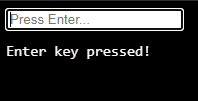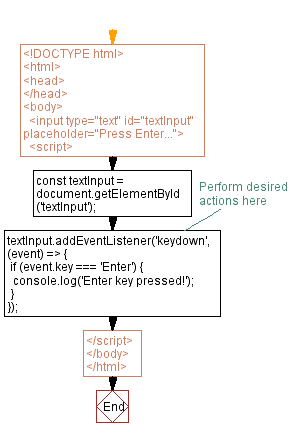JavaScript Enter key detection: Listen for keydown events on text input
JavaScript Event Handling: Exercise-9 with Solution
Enter Key Detection in Input
Write a JavaScript program that adds a keydown event listener to a text input to detect when the "Enter key" is pressed.
Sample Solution:
HTML and JavaScript Code:
<!DOCTYPE html>
<html>
<head>
</head>
<body>
<input type="text" id="textInput" placeholder="Press Enter...">
<script>
const textInput = document.getElementById('textInput');
textInput.addEventListener('keydown', (event) => {
if (event.key === 'Enter') {
console.log('Enter key pressed!');
// Perform desired actions here
}
});
</script>
</body>
</html>
Output:


Note: Executed on JS Bin
Explanation:
In the above exercise -
- First we define an input element with the id "textInput". The JavaScript code retrieves this input element using document.getElementById('textInput') and assigns it to the textInput variable.
- Next we attach an event listener to the text input using the addEventListener method. We specify the event type as "keydown" to detect when any key is pressed while the text input has focus.
- Inside the event listener function, we check if the event.key property is equal to "Enter". If it is, we log a message to the console indicating that the Enter key was pressed.
Flowchart:

Live Demo:
See the Pen javascript-event-handling-exercise-9 by w3resource (@w3resource) on CodePen.
For more Practice: Solve these Related Problems:
- Write a JavaScript program that listens for the Enter key in a text input and automatically submits the form.
- Write a JavaScript function that detects an Enter key press in an input field and triggers a search action.
- Write a JavaScript program that logs a custom message to the console when the Enter key is pressed inside a designated input.
- Write a JavaScript function that prevents default form submission on Enter and processes the input value instead.
Go to:
PREV : Progress Bar Update.
NEXT : Double-Click Event Action.
Improve this sample solution and post your code through Disqus.
What is the difficulty level of this exercise?
Test your Programming skills with w3resource's quiz.
